The Oratorio dei Crociferi is one of those little Venetian jewels to be discovered. It stands on the left side of the Campo dei Gesuiti, almost in front of the church of Santa Maria Assunta and inside it contains eight beautiful paintings by Palma il Giovane.
The ancient building
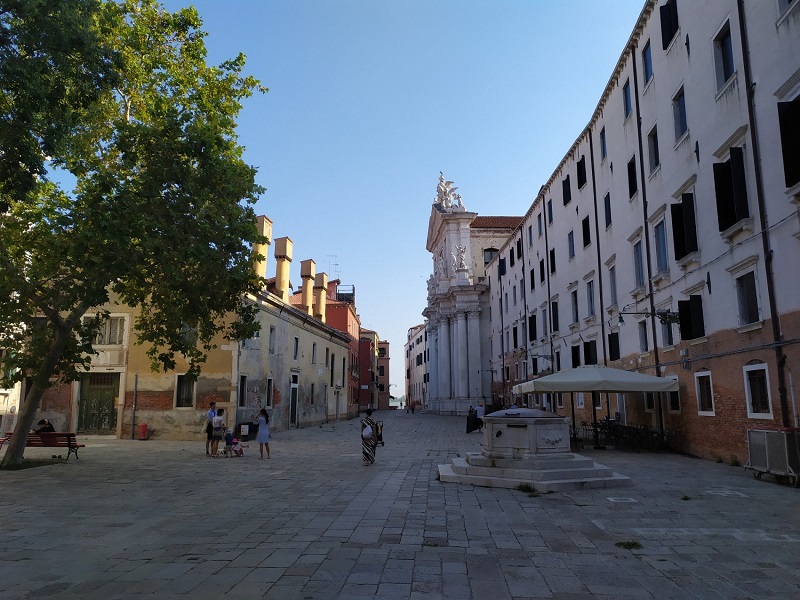
The Oratorio dei Crociferi is located a stone's throw from Fondamenta Nove and is one of the most hidden places in Venice that have a very special charm to discover.
An integral part of a medieval building, the Oratory has a gabled structure and was built in the twelfth century with the function of a hospital ruled by the Cruciferous Fathers. It was originally built with the purpose of giving accommodation and care to those who were leaving for the Holy Land. During the 14th century the same place became a shelter for destitute women who found hospitality here and had the opportunity to learn a manual trade.
The appearance of the oratory is simple, with a gothic facade and an aerial passage that allows direct connection to the palace that belonged to the noble Zen family. As evidence of the presence of the order there are crosses that surmount the portal of the building in front of the oratory.
The pictorial cycle of Palma il Giovane in the Oratory of the Crucifers
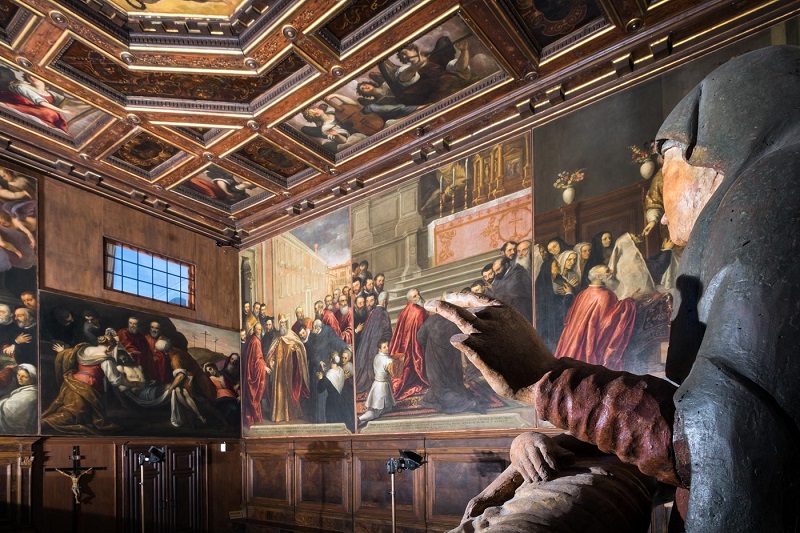
What makes the Oratorio dei Crociferi particularly interesting is the pictorial cycle created by Palma il Giovane between 1583 and 1592.
A unicum among the works of Venetian artistic culture of the sixteenth century because, in addition to the School of San Rocco painted by Tintoretto, this is the only pictorial complex to have been made by a single artist. Moreover, this work is considered one of the best of Palma il Giovane, which was at the time in what art historian Pietro Zampetti called "the most balanced period of the artist's activity".
The great pictorial cycle was commissioned by Doge Pasquale Cicogna to the famous Venetian painter and is composed of eight canvases that narrate episodes related to the Cruciferous Fathers and the two benefactor doges. The eight canvases can be divided into three categories: the history of the Crucifers and their hospital, the function of the Oratory as a chapel of a hospice and finally the representation of the liturgical character typical of the chapels of the time.
The painter and writer Carlo Ridolfi talks about the works of Palma il Giovane already in 1648 in his treatise "Le meraviglie dell'arte", a collection of biographies of illustrious Veneto painters. The text tells of the painter's devotion to the Crucifixion Fathers that originates from the fact that from an early age "it was from those he had in protection". Ridolfi himself then continues with a detailed description of the individual canvases, explaining what is depicted there and the meaning of the painted images.
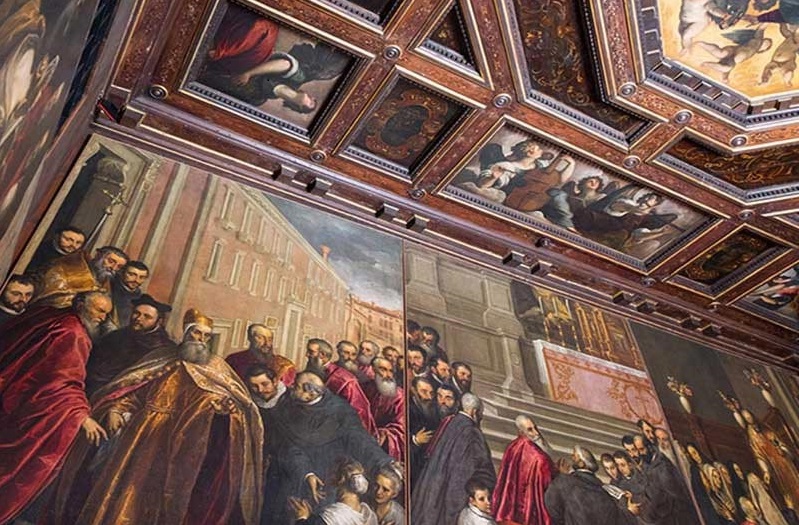
A tale in eight canvases
The pictorial cycle begins with the story of the institution of the congregation with the painting placed at the side of the altar and representing Pope Cleto establishing the Order of the Crucifiers. Here are depicted in Castel Sant'Angelo, in Rome, four friars who receive from the Pope the communication of the recognition of the Crucifer Fathers as a religious order dedicated to the protection of the Crusaders leaving for the Holy Land.
On the other side of the altar is placed the canvas with Pope Paul IV while he gives a Brief to the Venetian ambassador. The Doge Renier Zen, shown here, had bequeathed a sum of money to the Crucifer Fathers. Palma il Giovane represents in this canvas the moment in which a Venetian ambassador gives to the Crucifers the document that puts them in the knowledge of this legacy.
The two canvases are connected by painted architectural arches, to symbolize the union between Rome and Venice, the latter present in the second canvas with the Jesuit camp where the Oratory stands.
In front of the entrance of the building there are three canvases with the Doge Pasquale Cicogna, protector of the Cruciferi.
The first of the paintings depicts the highest Venetian charge of the time while attending the mass celebrated inside the Oratory by Father Priamo Balbi, in the presence of some destitute women. The next scene depicts Pasquale Cicogna receiving from the prefect the announcement of his appointment as Doge of Venice. The third work finally dedicated to Cicogna depicts him, now doge, dressed in gold while he visits the church of the Cruciferi.
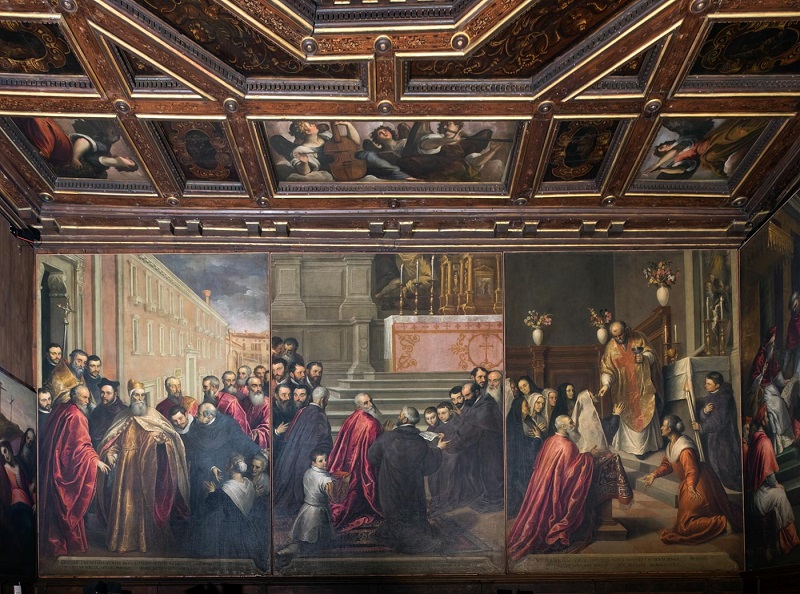
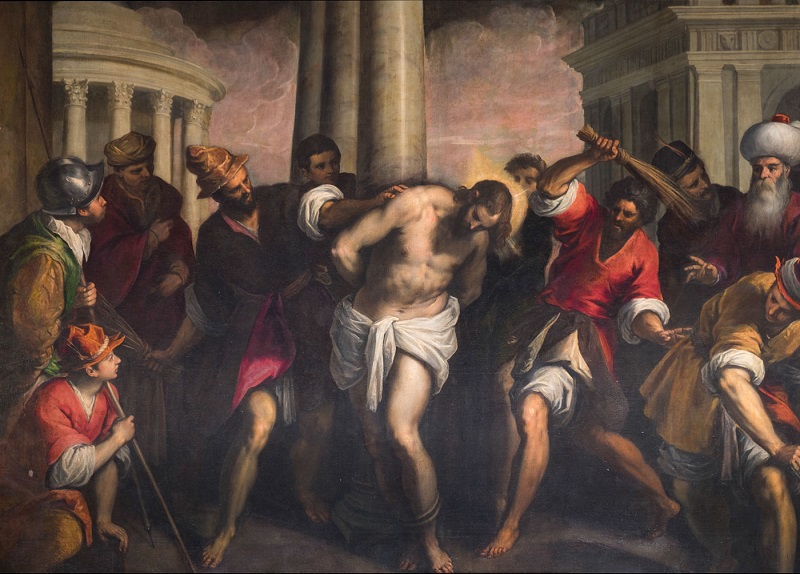
The last three canvases, placed respectively above the entrance of the Oratory, along the path that led to the burial place and the exit to the old hospice, all refer to the liturgical character of the Oratory as a chapel.
The religious character of these paintings is underlined by Palma il Giovane with the depiction of Jesus: The Flagellation of Christ reminds the visitor of the suffering of humanity and the need for the individual to purify himself in order to enter the sacred place.
With The Transportation of Christ the painter exemplifies the passage of the hospital guests to the afterlife and finally with the eighth canvas, divided into two distinct parts, is depicted on the one hand Christ in Blessing Glory, the Doge Renier Zen, the Dogaressa and on the other hand the Procurators of St. Mark's, some Fathers Crucifiers and women of the hospice.
Due to the flood of November 1966, the painting cycle of Palma il Giovane suffered major damage and for about twenty years it was no longer possible to admire it. The work was then returned to the public in 1984, after restoration. It was a long and meticulous restoration work promoted by UNESCO and financed by IRE (Institutions of Hospitality and Education) together with a good number of international committees for the safeguard of Venice: Venice in Peril Fund (England), Pro Venezia (Sweden), Stichting Nederlands Comité Venetie (Holland), Friends of Venice (Dallas Texas).
The cycle of Palma il Giovane despite the time and damage caused by water is fortunately still practically intact today. In fact, only the altarpiece that was on the altar is missing.
Living Venice as protagonists, staying in the heart of the city
Perfect for visiting the Oratorio dei Crociferi, as well as the many other beauties of Venice, TT&P Apartments can be the ideal solution: a way to experience Venice as protagonists and immerse yourself in the atmosphere that only this unique place in the world can offer.
The three apartments available to TT&P Apartments are different one from the other, but with the common characteristic of being located in strategic points of the city, as well as some of the most important areas such as Rialto, San Marco and Fondamenta Nuove.
They are not just apartments, but a real experience because at the center of every stay there is always the person. Each apartment is in fact cared for in detail to make its guests feel at home. The traditional ambience is not lacking in the comfort of the services, efficient and modern to welcome and pamper those who stay there in the best way possible.
Ca' XXII Marzo Boutique is located a few steps from "Gran Teatro La Fenice" and then from St. Mark's Square: a large apartment of 90 square meters that blends the Venetian tradition, with its original Murano glass chandeliers and the modernity of its furnishings, sophisticated and always suitable for the environment.
The apartment can accommodate up to six people and has two large rooms with double bed and flat screen TV. One of these is characterized by the presence of a modern sauna and a ceiling decorated with a valuable historical fresco.
There are also two bathrooms: one with shower with chromotherapy and one with a spa bathtub.
The kitchen equipped with dishwasher and microwave oven has everything you need to cook. The large living room has a sofa bed and a flat screen television. Last but not least, the presence of washing machine and tumble dryer complete the rich offer of services of this valuable apartment.
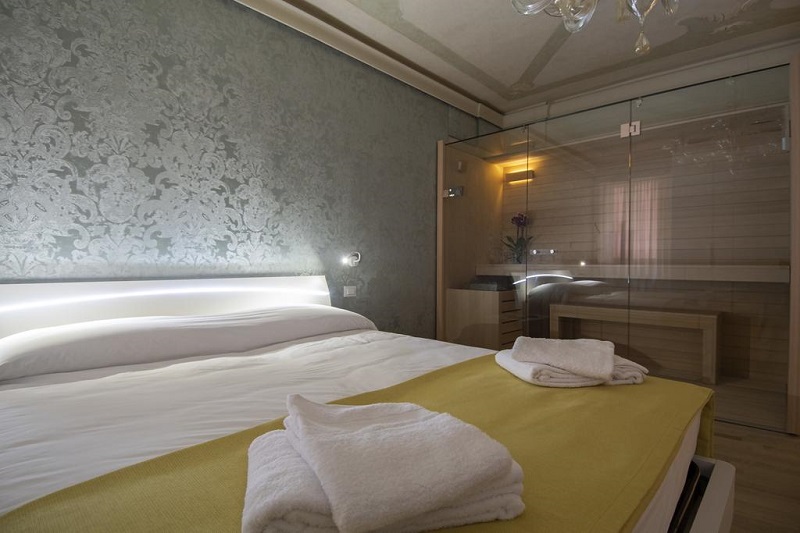
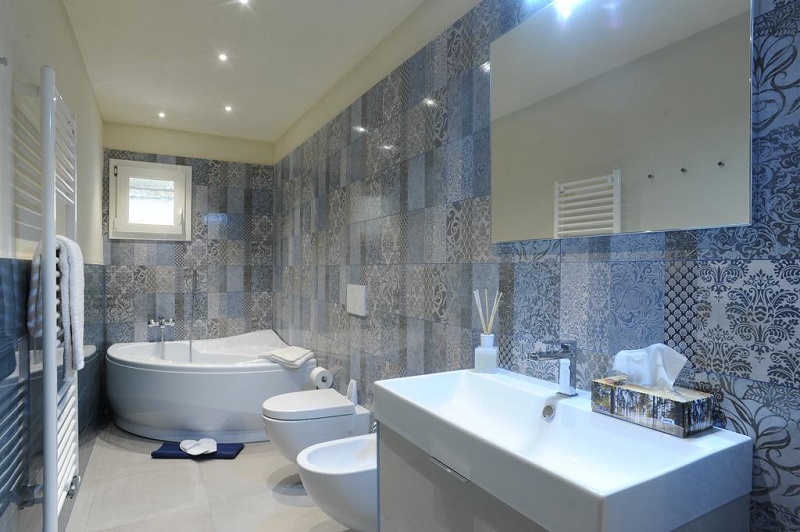
Located in the San Polo district, the Ca' Riva del Vin apartment is just a few steps from the Rialto bridge and ten minutes from San Marco: the Venetian context with original floors and modern furniture in full harmony with the environment is also interesting in this case.
The 66 square meters apartment is ideal for 4 people, with a double bedroom with flat screen TV and large closet. In the living room there is a double sofa bed and flat screen TV. The kitchen is equipped with microwave oven, fridge and has everything you need for cooking. The bathroom has a shower with hydro-massage spray and chromotherapy, perfect for relaxing after a pleasant walk through Venice. In the the dressing room there is a washing machine and a tumble dryer.
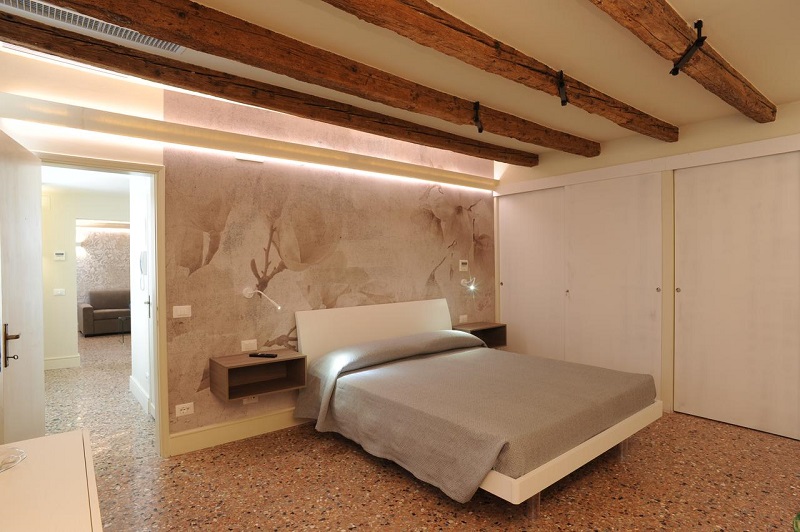
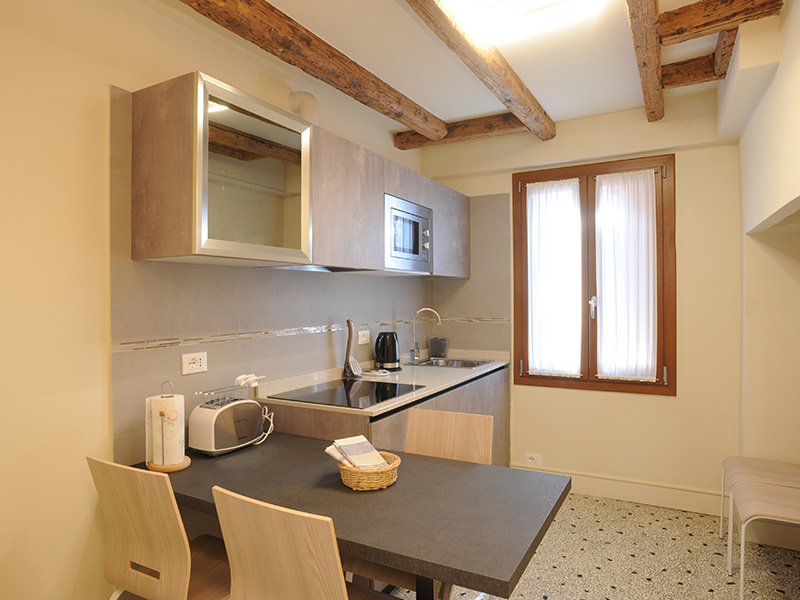
The apartment Paradiso Ca' Giulia, at Fondamenta Nuove, has as characteristic the comfort of the main water connections as well as being 10 minutes from Rialto and 15 minutes from San Marco: perfect for those looking for peace and feel like a real local.
The apartment of 60 square meters in fact has a beautiful garden, which is rare in Venice, where you can have breakfast or simply enjoy this corner of green.
Two bedrooms, a kitchen equipped with everything you need, a living room with a comfortable sofa to relax in front of the TV.
The bathroom has a comfortable shower and a laundry room with a washing machine and an ironing board that can be useful during the stay.
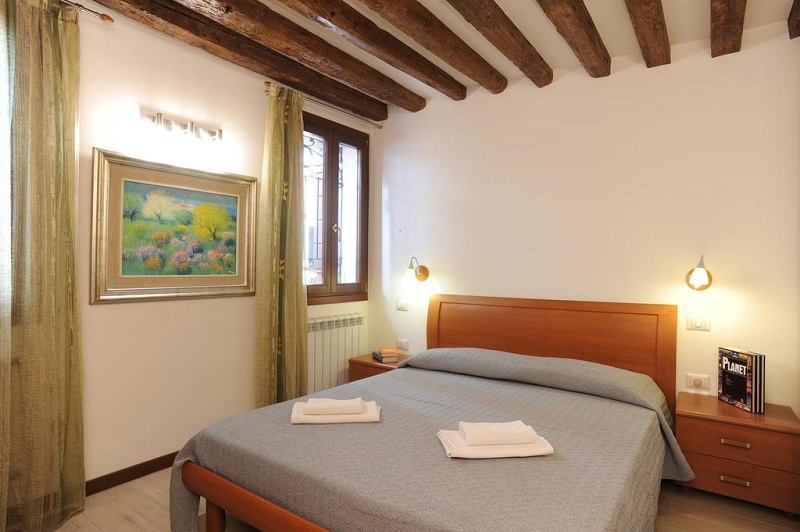
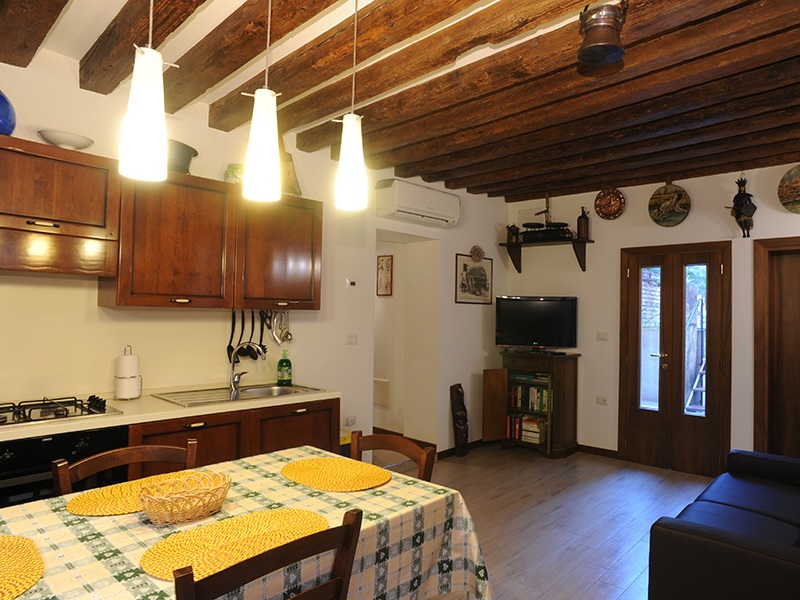
TT&P Apartments has its registered office at Palazzo Bianca Cappello, San Polo 1279/A .
For information: info@ttpveniceapartments.it










Lascia un commento